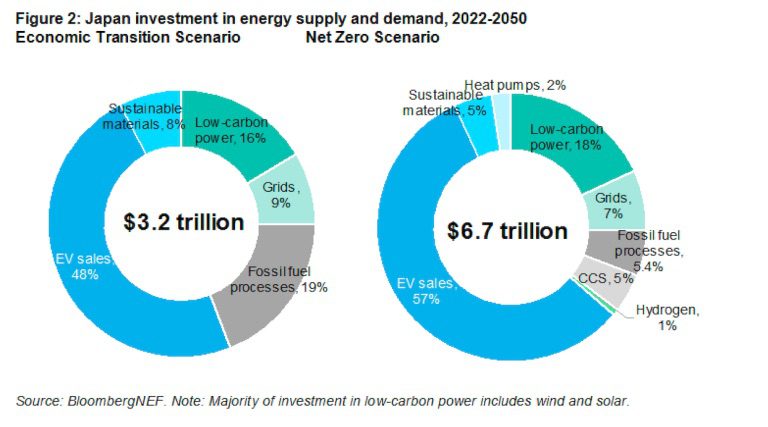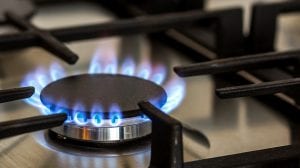Japan can achieve net zero emissions by 2050 without compromising its energy security by accelerating the deployment of mature clean technologies such as wind, solar and electric vehicles, and with minimal need to rely on green hydrogen.
These are the headline findings from a new report published Tuesday by energy analysts BloombergNEF (BNEF) which details two transition scenarios for Japan’s energy system and the resulting economic opportunities and challenges.
The study is of particular interest for Australia, because many of its green hydrogen project ideas are based on the assumption that Japan, like other north Asia economies, will be largely dependent on green hydrogen for their decarbonisation plans.
However, BNEF’s Net Zero Scenario for Japan report says Japan can catch up to its G7 peers by maximising deployment of solar and wind, ramping up energy storage deployment, installing carbon capture and storage (CCS) for existing thermal power plants, and restart its shuttered nuclear power plants.
BNEF also says that Japan can tap into its abundant geothermal potential.
It says Japan must also give up on unproven and more expensive technologies. Japan’s focus on a massive hydrogen strategy has provided generous subsidies for fuel cell passenger vehicles and residential fuel cell co-generation systems.
However, as BNEF highlights, there are much cheaper and more effective ways to decarbonise passenger vehicles and residential buildings.
According to BNEF’s analysis, while Japan’s current 2050 target calls for annual hydrogen demand of 20 million tonnes, its report suggests the country requires only 7 million tonnes of hydrogen.
“As Japan’s supply of clean hydrogen will be limited due to its geography, the government should prioritise sectors where clean hydrogen will be the most effective decarbonisation pathway,” said Toshiya Shinagawa, Japan associate at BNEF.
“Japan will likely need to rely more on CCS compared to hydrogen for heavy-industry decarbonization, but its current carbon tax on fossil fuels – ¥289 ($2) per ton of CO2 – is too low to attract investment in CCS.”
Focusing on the more ambitious of the two scenarios, BNEF’s Net Zero Scenario (NZS), the report outlines how Japan can ramp up its installed capacity of wind and solar to 689GW by 2050 – more than eight times the 81GW installed as of 2021.
By 2050, BNEF’s NZS sees wind and solar together account for 79% of Japan’s electricity supply, followed by nuclear power with 11%, and the remaining 10% filled out by a range of hydroelectric, geothermal, and thermal power plants equipped with CCS.
This represents Japan’s cheapest way forward to eventually decarbonise its power supply.

Importantly, even BNEF’s less-ambitious Economic Transition Scenario (ETS) shows that solar and wind still become the dominant source of electricity supply by 2050, accounting for 62% of all electricity generated.
BloombergNEF’s report seems insistent on the need for Japan to maintain some degree of fossil fuel-based generation – though it is unclear whether this is based on geographic or resource restrictions or economic limitations.
For example, even in BNEF’s net-zero scenario, fossil fuel investment through 2050 remains at $US359 billion, and to abate fossil fuel emissions, Japan needs to invest $US315 billion in CCS technologies.
Overall, to stay on track for net-zero using a combination of CCS and renewable energy technologies requires Japan double the rate of investment through 2050 for an annual average of $US239 billion, or around 3.8% of expected gross domestic product.
This might sound like a lot, but as David Kang, head of Japan and Korea research at BNEF explains, “Japan spent $1.8 trillion on fossil fuel imports over 2010-2022, equivalent to an annual average spending of more than 3% of GDP.”
“If Japan can redirect some of this expenditure toward deployment of mature clean technologies such as solar, wind, and electric vehicles, it would create more domestic economic opportunities while reducing emissions and strengthening its energy security.”

The underlying focus of BNEF’s analysis, however, is the need for Japan to reduce the hurdles faced by renewable energy developers by increasing the transparency of grid connection processes.
Japan must also shorten and simplify the permitting process for new renewable energy projects, while local government-led reverse auctions with guaranteed access to land or seabed and grid connections can also help accelerate deployment of renewables.
“Fossil-fuel power generation accounts for more than 70% of Japan’s electricity generation today,” said Isshu Kikuma, Japan senior associate at BNEF.
“Instead of pursuing costly unproven approaches such as retrofitting existing coal power plants for co-firing with ammonia, Japan would be better served accelerating the deployment of geothermal, solar and wind.”









